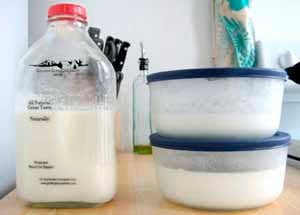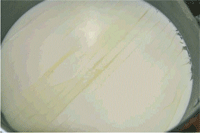Let’s face it- we’re not all scientists. Probiotics is all about strains of bacteria. There is a lot of information about bacteria out there, but some of us have to visualize it to understand it.
Fortunately, there are many videos on UTube about probiotics. In particular, one called “Forever Living Probiotic Products” (picture at right) shows the good bacteria dramatically rescuing Boweltown from the bad bacteria. It’s very cute!
Most of the information in this article came from a more restrained UTube video called “Why we should be taking probiotics.” Dr. Gerald Lewis from New Zealand gave us permission to use much of the content in this article.
We are tackling this controversial subject because one of our customers, Heidi Elbert, wrote us the following note:
I have made the Y5 Yogurt many times and absolutely love it! Friends and family that I share it with usually agree it is the best textured/flavored yogurt they have ever had. So glad to have found you all through “Animal, Vegetable, Miracle!”
My question is, I would like to have some kind of approximation of the probiotic levels in the Y5 yogurt. If I’m not getting enough probiotics through my homemade yogurt then I may start taking a supplement (which I don’t really want to do.) Would you have any information on probiotic count or a source that I could contact? I have looked on the website and could not find anything.
We contacted our culture supplier, and they sent us the chart above, showing how the probiotic content of yogurt deteriorates over time. The first 2 weeks are stable, but it plunges down after that. This was interesting, but it didn’t really answer the question.
Finally, our answer came from the company that manufactures our cultures:
In an 8 oz (1 cup) serving of our Y5 yogurt, you could expect the following numbers:
L.acidophilus = 3-4 billion per serving
Bifidobacterium = 1-2 billion per serving
So, now, what does this mean? There is no minimum daily requirement of probiotics because this is bacteria that proliferates rapidly and replaces itself in our systems.
When you buy supplements, they range from a total of 5 billion to more than twice that amount.
There are hundreds of species of bacteria in our digestive tracts. We have no idea which ones we need or how often we need to replenish them. So, what do we know? Let’s start at the beginning:
What are probiotics?
Probiotics are naturally occurring beneficial bacteria located in the intestines. Their job it is to help prevent harmful bacteria from wreaking havoc.
What do the good bacteria do for us?
Keep the bowel clean
Break down food
Help make B and K vitamins
Suppress bad bacteria
What are harmful bacteria?
Examples are E. Coli, Salmonella and Clostridia
What do the bad bacteria do?
Damage our stomach walls leading to immune diseases
Cause Infections-yeast, urinary and vaginal
Cause Putrefaction, flatulence, bad breath, bloating
Cause Inflammation, depression, brain fog
Stop absorption
What is the ideal balance?
Ideally, our digestive tract maintains a balance of 85% good bacteria and 15% bad.
What causes the balance to be disrupted?
Antibiotics strip our intestines of good and bad bacteria. Afterwards, the bad bacteria usually become more prevalent than they were before.
What if I haven’t taken antibiotics?
We all consume antibiotics in:
Pills for any infection
Our food- meat, eggs, milk, fish, chicken
Chemicals and sprays-anything that kills bacteria
What species are most of the bacteria in our stomachs?
Lactobacillus and Bifidobacterium
Where can I get that bacteria?
1. Yogurt, unpasteurized milk, kefir, miso, sauerkraut, tempeh, umeboshi plum, some juices and soy beverages.
2. Dietary supplements
Note: Pre-biotics are foods with a lot of soluble fiber that support the growth of probiotics in our systems. They should always be taken with probiotics. Foods that are especially helpful are those with Fructo-oligo-saccharides (FOS), like bananas, onions, garlic, artichokes, barley and tomatoes.
How do I know if I might need probiotics?
If you have symptoms of intestinal distress: diarrhea, bloating, flatulence.
When you have been ill or under stress.
During and after a course of antibiotics.
After an overseas trip-or while travelling.
After bowel surgery.
If you have urinary and vaginal infections.
If you have food allergies.
If you have Crohn’s disease, ulcerative colitis, inflammatory bowel disease or other immune diseases.
When you have Eczema-especially in children.
If you are old or have a weakened immune system.
What should I do?
Dr. Lewis recommends:
Ask your doctor if you may take a course of top quality probiotics. If so, take a course of it every few months.
Regularly eat yogurt, kefir, miso, etc.
Reduce the amount of high sugar and highly processes foods in your diet.
Regularly eat pre-biotics (soluble fiber).
What should I look for in a probiotic supplement?
There should be something in them to enable them to survive the acids in your stomach so they can reach your lower intestine. The capsules may be enteric coated, for example.
Our answer to Heidi’s question:
It is probably a good idea to take a one or two week course of probiotics every few months, with your doctor’s permission.
Our Y5 yogurt, eaten regularly, will provide more than enough of the two main probiotics to keep your system healthy.
























































































































































